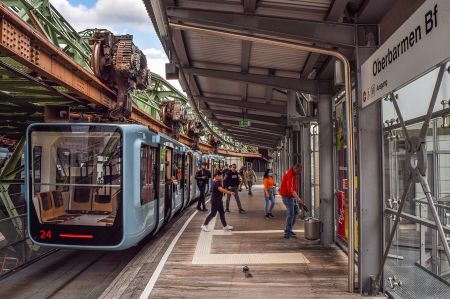On to the suspension railway in Wuppertal - an experience
- Written by Portal Editor
With a length of 13.3 kilometres, the Wuppertal Suspension Railway is not only a monument of German industrial history that is unique in the world, but also the most important means of transport in the city. Over the past 120 years, it has transported more than 1.5 billion people.
Since the official start in March 1901, the popularly known as "hard dragon" has connected the east with the west of Wuppertal. For more than 120 years, the people of Wuppertal “from the city where the buses fly” have been using their suspension railway and attract hundreds of thousands of foreign guests every year.
The suspension railway - floating through the city without traffic jams
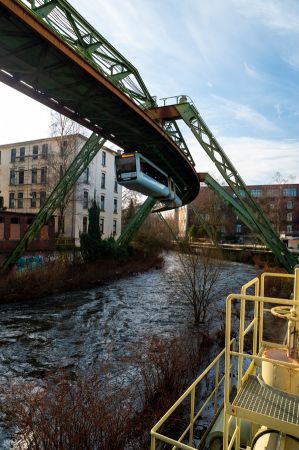 The citizens of Wuppertal love their suspension railway as a fast, congestion-free and indispensable means of transport through the valley axis, largely following the course of the Wupper. And the suspension railway is also weatherproof: rain and snow don't bother it. Every day, 85,000 passengers use the fast route over heads and streets - at a maximum of 60 kilometres per hour.
The citizens of Wuppertal love their suspension railway as a fast, congestion-free and indispensable means of transport through the valley axis, largely following the course of the Wupper. And the suspension railway is also weatherproof: rain and snow don't bother it. Every day, 85,000 passengers use the fast route over heads and streets - at a maximum of 60 kilometres per hour.
As just mentioned, the route runs mostly over the Wupper, but between the main church in Sonnborn and the Vohwinkel terminus, the suspension railway runs over the streets of the city. She crosses the A46 at the Sonnborner Kreuz and pushes her way very close to the houses on Kaiserstrasse.
Incidentally, a journey between the two end stations of Oberbarmen and Vohwinkel takes around 30 minutes. There are a total of 20 stations along the 13.3-kilometer route - from the Art Nouveau station at Werther Bridge to the modern glass construction at Kluse, which opened in 1999.
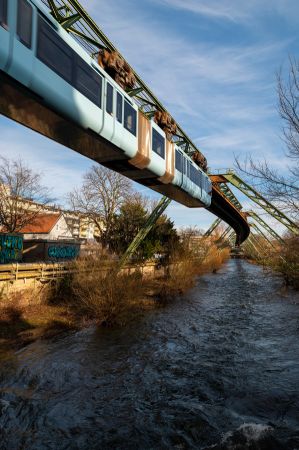 Since August 1, 2019, only the new, sky-blue Generation 15 cars have been driving high above Wupper and the streets, which allow completely new views with their large panoramic windows.
Since August 1, 2019, only the new, sky-blue Generation 15 cars have been driving high above Wupper and the streets, which allow completely new views with their large panoramic windows.
But the historical Kaiser Wagen, in which Kaiser Wilhelm II and his wife Auguste Viktoria undertook a test drive in 1900, also has its own special appeal. Carefully restored, it is now used for coffee, morning pint and light rides or as a wedding carriage, in which a civil marriage is also possible. However, the Kaiser Wagen is currently being prepared for the new operating system and is expected to be on the road again from autumn 2024.
The suspension railway map accompanies us from station to station and even offers numerous tips on things worth seeing within reach of the respective stops.
Discover the valley with the suspension railway
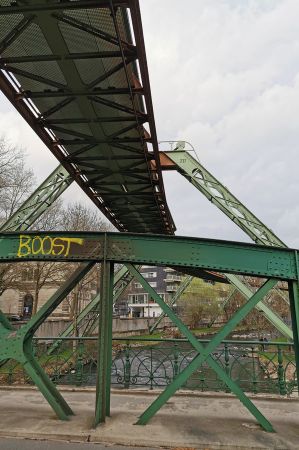 The suspension railway runs over 13.3 kilometres through the Wuppertal, of which a good ten kilometres with numerous stations are on the route over the river. Some of these suspension railway stations have been preserved in the Art Nouveau style, they were replaced by new or identical stations in the course of modernization and some of them were effectively illuminated. Its architecture sets distinctive signs in the city, especially for photo enthusiasts.
The suspension railway runs over 13.3 kilometres through the Wuppertal, of which a good ten kilometres with numerous stations are on the route over the river. Some of these suspension railway stations have been preserved in the Art Nouveau style, they were replaced by new or identical stations in the course of modernization and some of them were effectively illuminated. Its architecture sets distinctive signs in the city, especially for photo enthusiasts.
One of the most popular motifs at the Vohwinkel terminus is the view through the Kaiserstraße lined with shops, where the suspension railway passes close to venerable houses from the Gründerzeit.
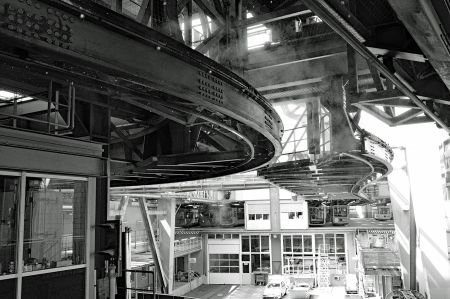 It continues via the confusing Sonnborn motorway junction to the Stadion am Zoo, where the train is led to the river via support 100, a technical masterpiece. It's worth getting off shortly after and paying a visit to the Wuppertal Zoo. Its hilly location, the extensive lion enclosure or the penguin enclosure with an underground glass tunnel are unrivalled attractions in Germany.
It continues via the confusing Sonnborn motorway junction to the Stadion am Zoo, where the train is led to the river via support 100, a technical masterpiece. It's worth getting off shortly after and paying a visit to the Wuppertal Zoo. Its hilly location, the extensive lion enclosure or the penguin enclosure with an underground glass tunnel are unrivalled attractions in Germany.
Impressive evidence of the Bergisch pioneering spirit is the factory premises of the global corporation Bayer, founded in Wuppertal, over which the railway hovers. Passing the Briller Quarter, Germany's largest contiguous district of listed villas, you reach the centre of Elberfeld. During the day it invites you to go shopping or to visit the Von der Heydt Museum, in the evening to a concert in the historic town hall or to a pub crawl through the Luisenviertel.
The Ohligsmühle and Kluse suspension railway stations impress there with their bold, ultra-modern architecture, while the imposing regional court (1854) is one of the oldest in Germany. High above, to the north of the Wupper, is the Hardt recreation area with the botanical garden, to the south of the river the unique Waldfrieden sculpture park by artist Tony Cragg.
Please read as well:
Doğan Akhanlı and the indivisibility of human rights
Regensburg - Roman fort and sausage roastery on the Danube
-
 Wuppertal suspension railway above river
Wuppertal suspension railway above river
Wuppertal suspension railway above river
Wuppertal suspension railway above river
-
 Wuppertal suspension railway above river
Wuppertal suspension railway above river
Wuppertal suspension railway above river
Wuppertal suspension railway above river
-
 Wuppertal suspension railway above river
Wuppertal suspension railway above river
Wuppertal suspension railway above river
Wuppertal suspension railway above river
-
 Wuppertal suspension railway above river
Wuppertal suspension railway above river
Wuppertal suspension railway above river
Wuppertal suspension railway above river
-
 Wuppertal suspension railway above river
Wuppertal suspension railway above river
Wuppertal suspension railway above river
Wuppertal suspension railway above river
-
 Wuppertal suspension railway above river
Wuppertal suspension railway above river
Wuppertal suspension railway above river
Wuppertal suspension railway above river
-
 Wuppertal suspension railway above river
Wuppertal suspension railway above river
Wuppertal suspension railway above river
Wuppertal suspension railway above river
-
 Wuppertal suspension railway above river
Wuppertal suspension railway above river
Wuppertal suspension railway above river
Wuppertal suspension railway above river
-
 Wuppertal suspension railway above river
Wuppertal suspension railway above river
Wuppertal suspension railway above river
Wuppertal suspension railway above river
-
 Wuppertal suspension railway above river
Wuppertal suspension railway above river
Wuppertal suspension railway above river
Wuppertal suspension railway above river
-
 Wuppertal suspension railway above river
Wuppertal suspension railway above river
Wuppertal suspension railway above river
Wuppertal suspension railway above river
-
 Wuppertal suspension railway above river
Wuppertal suspension railway above river
Wuppertal suspension railway above river
Wuppertal suspension railway above river
https://www.alaturka.info/en/germany/north-rhine-westphalia/6066-on-to-the-suspension-railway-in-wuppertal-an-experience#sigProIdd120e91fe9
